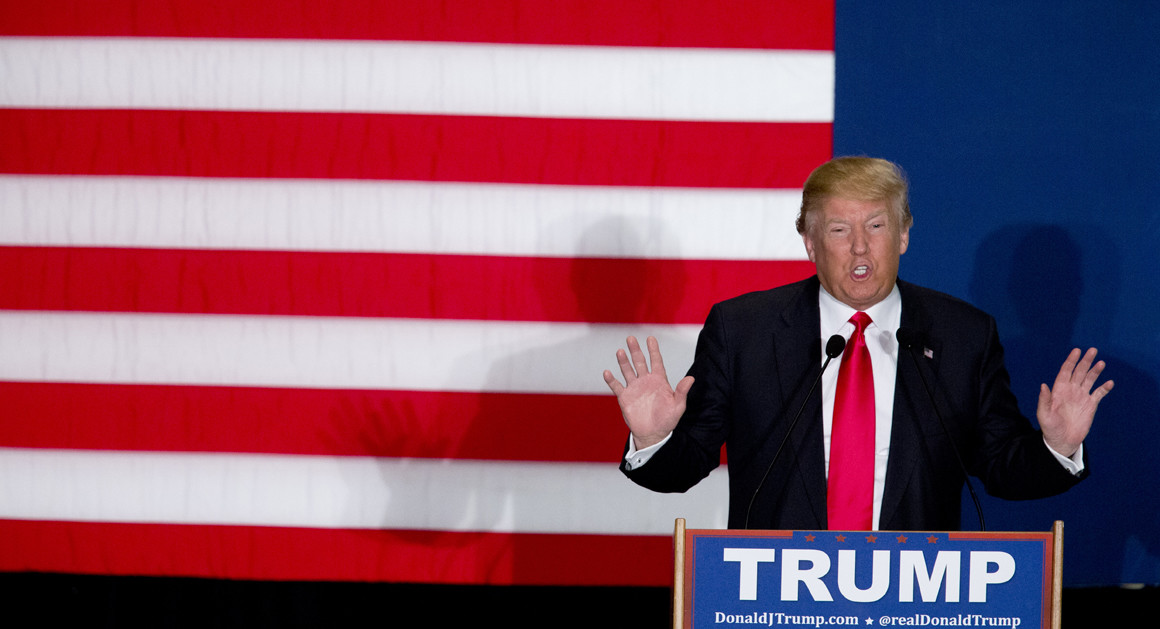
For months, Donald Trump’s allies urged him to invest in the technology necessary to identify and mobilize his supporters, sources close to Trump’s campaign told POLITICO, but the billionaire barely budged, apparently believing his star power would provide a new way to mobilize voters.
By the time his campaign began investing in voter data and targeting analytics, his rivals for the GOP nomination — particularly Iowa winner Ted Cruz and third-place finisher Marco Rubio — had spent millions building sophisticated voter-targeting machines.
Trump’s campaign lacked the voter-targeting and turnout capabilities to translate a 7-point polling lead in Iowa into a win in Monday’s Iowa caucuses, and his disappointing second-place finish hinted at potential trouble for him in upcoming states that should otherwise be more favorable.
Cruz and Rubio’s campaigns ran circles around Trump’s bare-bones operation, which gambled that Trump’s star appeal could overpower modern organizing tactics, and relied instead on big rallies, an outlandish social media presence, a flashy endorsement from Sarah Palin and a late advertising blitz to try to get supporters to the polls.
Trump’s backers maintain that the most painful part of his loss to Cruz, by a 3.3-percentage-point margin, is that it never should have happened. Trump actually won the battle for supporters, they believe, especially among nontraditional Republican voters, but he lacked the tools to get them to participate in Iowa's Byzantine caucus system. As a result, a candidate who could have been vaulted into New Hampshire with huge momentum on top of an impressive polling lead is instead looking shrunken and chastened.
Trump's staff “got outclassed and outmaneuvered ― the Iowa team simply didn’t have the tools they needed, which is why they overpromised and underperformed,” said a source close to the Trump campaign. “The Iowa team did an amazing job with the tools that they had, but that’s like saying that Al Qaeda did an amazing job in a battle with the U.S. Army because some Al Qaeda fighters didn’t get killed.”
On the ground in Iowa last month, Trump’s operation showed signs of disorganization and acrimony as it faced mounting doubts about its ability to identify and mobilize its high numbers of previously disengaged supporters and to persuade more traditional, but undecided, Republicans to caucus for Trump.
And some Trump allies were openly expressing doubts about the largely self-funding Trump’s willingness to pay for data analytics, as well as the aptitude of the campaign’s skeletal data team back in New York headquarters. It is headed by Matt Braynard and Witold Chrabaszcz, a pair of former data engineers for the Republican National Committee who lacked high-level national campaign experience. With less than a month to go until the caucuses, sources say, Braynard was still working to assemble a team to do what he described as a combination of high-level statistical analyses and “unglamorous political grunt work.” When one experienced data engineer asked when he could start working for the Trump campaign, Braynard immediately responded: “Now.”
The campaign didn’t start seriously building a data operation to target voters until mid-October, sources said, and even then it did not act with urgency. It waited until November to begin paying a data vendor, the nonpartisan firm L2, and until late November or early December to sign an agreement allowing it to use the RNC’s massive voter file. The RNC had initially offered the arrangement back in June, and it's unclear what caused the delay in executing the agreement, but most other GOP campaigns signed similar agreements months before Trump.
At one point early in the campaign, Trump representatives talked to Cambridge Analytica ― the firm now being credited with engineering Cruz’s cutting-edge targeting operation ― about retaining the company’s services, but they decided it was too expensive. And, in early October, Trump’s Virginia state director, Mike Rubino, reached out to the nonpartisan voter data firm rVotes, writing in an email “We want to utilize this ASAP.” Steve Adler, rVotes' owner, said the Trump campaign never followed up.
Through the end of last year, the period covered by the most recent Federal Election Commission filings, Trump’s campaign had spent only about $560,000 on data-related costs, compared with at least $3.6 million for Cruz. Trump's data outlays included $235,000 to L2 for “research consulting," $17,500 to the voter data firm NationBuilder for software, and $200,000 in list rental payments to the conservative Newsmax Media. By contrast, the Trump campaign has spent at least $1.4 million on rally-related expenses and $1.2 million on hats ― presumably mostly for the now-iconic hats bearing Trump’s campaign slogan, “Make America Great Again.”
The campaign's lackadaisical data effort is seen in some quarters as coming down to Trump's lack of willingness to use his own cash on something that’s seen as essential in modern-day presidential politics. “Trump’s a businessman,” said Joe Rospars, who served as a chief digital strategist to President Barack Obama’s 2008 and 2012 campaigns. “He’s not going to spend any more money than he has to, and he made his bet.”
The Trump campaign did not respond to questions about whether its Iowa turnout suffered from an underfunded voter targeting and mobilization operation. L2 president Bruce Willsie ― who last month told POLITICO that his company will “continue to provide services to the Trump campaign, and the data package is a major part of that” ― on Tuesday declined to discuss its approach to boosting Trump in the upcoming states, or even whether it’s even still working with the campaign.
“I just have no comment on any individual campaigns with which we may or may not be working,” he said.
Meanwhile, the data teams working on Cruz’s campaign and a network of supportive super PACs were getting a lot of credit for their role in boosting the Texas senator to victory.
“In an election like this every small thing you do can be critical,” Chris Wilson, the Cruz campaign’s director of analytics and pollster, told POLITICO. “It was an overall component that was important to our success.”
The Cruz campaign data team ― internally dubbed the Oorlog project, named after the Afrikaner word for ‘war’ ― includes four full-time data scientists as well as employees from Cambridge Analytica, who have been embedded in the campaign’s Houston headquarters. The company, which is owned by one of Cruz’s biggest donors, worked with both the campaign and a network of linked super PACs to identify Cruz supporters and persuadable voters using what it called “psychographic” profiles culled from social media, and commercial and political data.
Through the end of 2015, the campaign had racked up $3.6 million in bills from Cambridge Analytica, while the super PACs, all of which are named iterations of Keep the Promise, had paid the company more than $750,000.
Not only are the data expensive, it’s costly to use them effectively.
The super PACs hired 10 canvassers and recruited dozens of volunteers to go door-to-door to contact people in Iowa whose Cambridge Analytica profiles suggested they were supportive of Cruz or could be persuaded to be.
Typically, the so-called match rate on such calculations is about 50 percent, said Drew Ryun, who runs the field operation for the umbrella super PAC, Keep the Promise PAC.
“Cambridge Analytica’s match rate was 70 percent of people who they said were leaning towards Cruz or were actually supporting Cruz,” said Ryun. “For all the talk over the last few years about the right being behind on voter ID and targeting, we’re experiencing a quantum leap forward right now.”
His group, which had been knocking on doors in Iowa for more than three months leading up the caucuses, has around 50 canvassers on the ground in upcoming states including South Carolina, Louisiana, Alabama, Oklahoma, Kansas and Missouri. “Retail politics doesn’t happen overnight," said Ryun. "It’s months and months of work.”
The Cruz campaign, meanwhile, used the voter profiles to shape its strategies for everything from television ad buys to telephone banks and door knocks. It built a list of more than 9,000 Iowans who were still on the fence between their candidate and Trump. The team divided the undecided voters ― who were heavily evangelical and 91 percent male ― into more than 150 different subgroups based off ideology, religion and personality type, Wilson said. It used Facebook experiments to determine which issues jazzed up their voters the most.
Rubio’s campaign, meanwhile, relied on a 22-person data war room — for Iowa and beyond — out of an 11th-floor suite of a downtown Washington office building near Metro Center. The analytics shop is stocked with Red Bull and a beer keg, a nacho cheese machine and an Xbox.
The campaign paid $750,000 to the company called 0ptimus to assist in the data operation. Its leader, Scott Tranter, answers directly to Rubio campaign manager Terry Sullivan. Tranter’s team prides itself on having internal models showing that Rubio had more than 20 percent support from Iowan Republicans with a potential turnout scenario to surpass Trump for second place, much better than the final Des Moines Register poll, which had him with 15 percent support behind both Cruz and a leading Trump.
Now, coming out of Iowa, the Rubio and Cruz campaigns are recalibrating their models and data sets to take into account a weakened Trump.
“Our probability scores are obsolete after last night,” said Wilson, Cruz’s analytics and polling director. “Everything changes as the campaign dynamics shift.”
Meanwhile, Trump has left many Republicans stumped as to the whereabouts of basic campaign infrastructure built off a solid data core, including targeted online ads and phone calls to GOP voters who have participated in past primaries.
“I’ve seen none in South Carolina,” said Katon Dawson, a former South Carolina GOP chairman who is unaffiliated since Lindsey Graham dropped out of the presidential race. Trump officials are "talking about it, but I know what one looks like, and I haven’t seen one.”
Still, the advantages of the superior data operations of Cruz and Rubio will be tested in next week’s New Hampshire primary. Polls taken before Iowa showed Trump with a commanding 20-point lead. And the state’s primary rules, which allow independents to participate, can be a major wild card, as is the turnout, which is far greater than for Iowa’s caucuses ― a potential advantage for Trump — but also a source of volatility.
“It’s not that you have to find people who may vote and dig them up here like you have to do in a caucus state,” said Andrew Smith, a political scientist at the University of New Hampshire-Durham. He cast doubt on the ability of statistical models to microtarget New Hampshire voters, arguing that “to a certain extent you can’t predict who’s going to show up.”
But the campaigns with sophisticated data operations believe they can make a difference — and that the main question will be whether Trump's lead will be too big to overcome, or if the billionaire will, once again, fail to turn out enough of his avowed supporters to win a winnable race.


